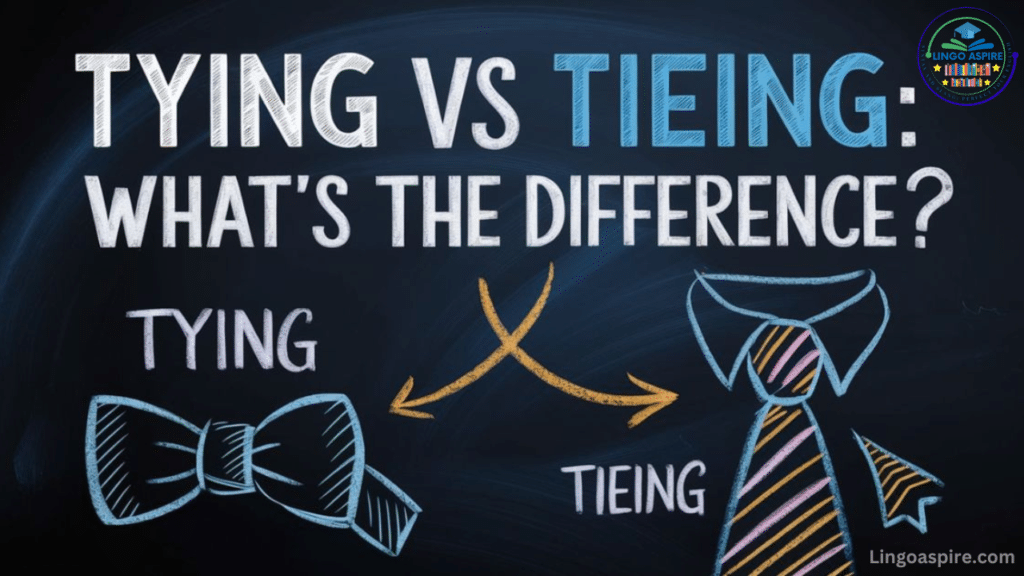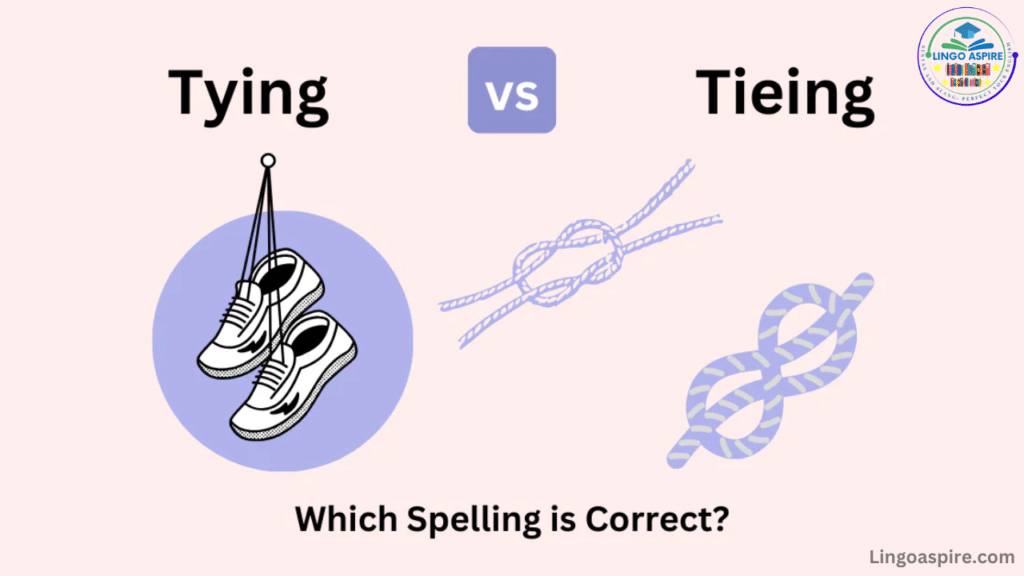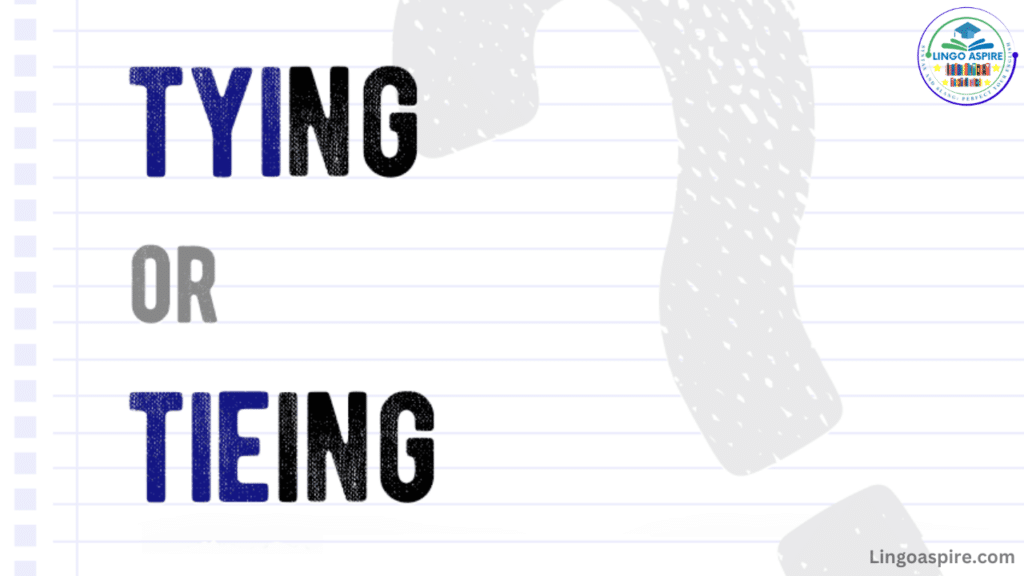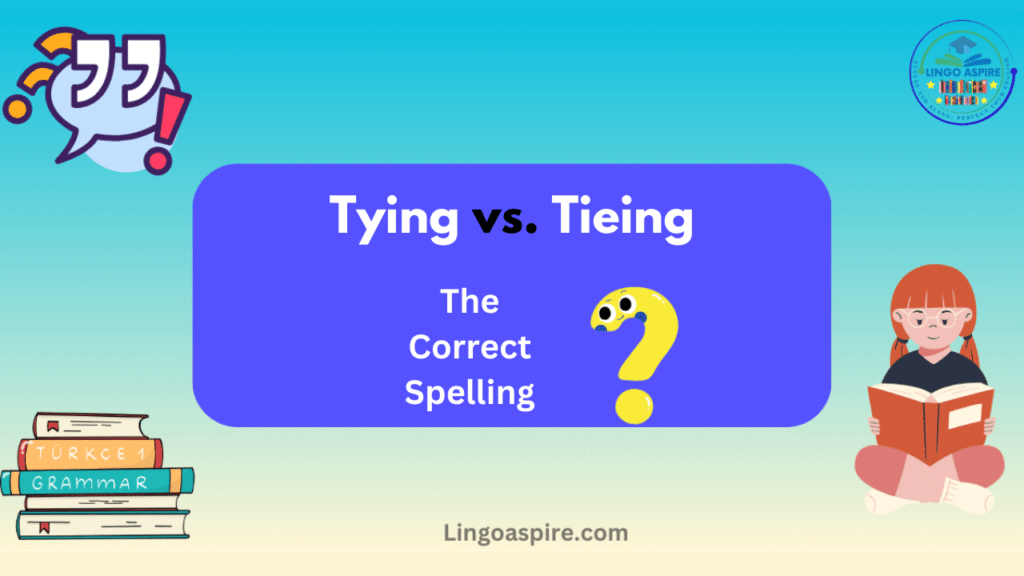Many people get confused when spelling the present participle of “tie.” Should it be tying vs. tieing? This confusion happens because of the way English spelling rules work, especially with words ending in “-ie.” Some think “tieing” follows standard spelling patterns, but in reality, it is incorrect. The correct spelling of tying follows a grammar rule that changes “-ie” to “-y” before adding “-ing.”
Mistakes in spelling happen even to native English speakers. This article explains the grammar rules for -ing words, why people make the tieing spelling mistake, and how to correctly use “tying” in sentences. You will also learn the meaning, history, synonyms, and examples.
Why Is There Confusion Between Tying vs. Tieing?

The main reason for the confusion comes from how verbs are changed when forming different tenses. Normally, when you add “-ing” to a verb, you simply attach it at the end. For example:
| Base Verb | Present Participle |
|---|---|
| Walk | Walking |
| Jump | Jumping |
| Run | Running |
| Talk | Talking |
| Eat | Eating |
| Write | Writing |
| Sing | Singing |
| Dance | Dancing |
| Swim | Swimming |
| Read | Reading |
However, English spelling rules create exceptions, especially for words ending in -ie like “tie.” Instead of simply adding “-ing,” the “-ie” changes to “y.” This is why “tying” is correct, and “tieing” is a spelling mistake.
Tying vs. Tieing: Which One Is Correct?
The only correct spelling of tying is “tying.” The word “tieing” does not exist in modern English and is considered an error. Some older texts might use “tieing,” but they are rare and outdated. If you see “tieing,” it is almost always an incorrect spelling of “tying.”
Many learners assume “tieing” is correct because other verbs do not change their spelling in this way. However, “tie” follows a special rule that applies to verbs ending in “-ie.” This same pattern appears in words like “die” (which becomes “dying”) and “lie” (which becomes “lying”).
Grammar Rules Behind Tying
English has a specific rule for words ending in -ie before adding “-ing.” Instead of keeping “ie,” you replace it with “y.” Here are some examples:
| Base Verb | Correct Present Participle | Incorrect Form |
|---|---|---|
| Lie | Lying | Lieing |
| Die | Dying | Dieing |
| Tie | Tying | Tieing |
This rule applies to maintain smooth pronunciation and natural word flow. Without this rule, words like “tieing” would be awkward to say.
Usage in American vs. British English

There is no difference in spelling between tying in American and British English. Unlike other words that have variations between the two dialects, such as color (American) vs. colour (British) or center (American) vs. centre (British), the word “tying” follows the same spelling rule in both versions of English.
However, differences in usage may exist in phrases or idioms. For example:
- In American English, “tying the game” is a common sports term.
- In British English, “tying in with a theme” is frequently used in literary discussions.
Despite these minor differences, tying remains the only correct spelling worldwide.
Meaning and Usage of “Tying”
The word “tying” comes from the verb “tie”, which means to fasten, bind, or secure something using a string, rope, or similar material. “Tying” is simply the present participle or continuous form, used when an action is happening right now.
For example:
- She is tying her shoelaces.
- The workers are tying the packages with rope.
- He kept tying the knot incorrectly.
In all these sentences, “tying” refers to the action of securing something.
Key Differences Between Tying vs. Tieing
Understanding the differences between tying vs. tieing is essential for proper spelling. Here is a breakdown of the key distinctions:
| Feature | Tying | Tieing |
|---|---|---|
| Correct Spelling | ✅ Yes | ❌ No |
| Follows English Spelling Rules | ✅ Yes | ❌ No |
| Used in Modern English | ✅ Yes | ❌ No |
| Found in Dictionaries | ✅ Yes | ❌ No |
| Used in Old English Texts | ❌ No | ✅ Rarely |
The table makes it clear that “tying” is the correct form, while “tieing” is an incorrect spelling that does not follow English grammar rules.
Common Synonyms for “Tying”
Sometimes, you may want to use a different word instead of “tying.” Here are some synonyms:
| Synonym | Meaning |
|---|---|
| Binding | Securing something tightly |
| Fastening | Attaching or closing something securely |
| Knotting | Making a knot in a rope, string, or fabric |
| Securing | Making sure something stays in place |
| Wrapping | Covering or enclosing something with a material |
These words work well, depending on the context. For example, “binding” is often used for legal agreements, while “knotting” is more common for ropes and shoelaces.
Example Sentences Using “Tying”
Using “tying” correctly in sentences helps reinforce the correct spelling. Here are some examples:
- Sarah is tying her hair into a ponytail.
- The captain is tying the boat to the dock.
- They are tying ribbons around the gift boxes.
- He was tying his tie when the phone rang.
- The firefighters are tying the safety ropes before the rescue.
These sentences show different ways “tying” is used in daily life.
Common Mistakes and How to Avoid Them

A frequent mistake is assuming that adding “-ing” to “tie” should follow the same pattern as regular verbs. This leads to the incorrect spelling “tieing.” To avoid this, remember the special rule for words ending in “-ie.” A helpful trick is to recall similar words like “dying” (from “die”) and “lying” (from “lie”), which also change “ie” to “y.” Practicing writing sentences with “tying” can reinforce the correct spelling. If you’re unsure, checking a dictionary or using spell-check can help confirm the proper form.
Tying Etymology and History
The word “tying” comes from the Old English “tīgan,” meaning to fasten or bind. Over time, spelling and pronunciation changed, but the tie spelling variations remained minimal. Older English texts sometimes used “tieing,” but this form was eventually phased out.
Historical records show that “tying” was consistently used in books, newspapers, and official documents, while “tieing” was almost non-existent. This confirms that “tying” has always been the correct spelling of tying.
Tying in Idioms and Expressions
Many idioms and expressions use the word “tying.” These phrases carry meanings beyond the literal sense:
| Idiom | Meaning |
|---|---|
| Tying the knot | Getting married |
| Tying up loose ends | Finishing remaining tasks |
| Hands are tied | Being restricted or unable to act |
| Tying someone down | Limiting someone’s freedom |
| Tying in with something | Connecting one thing to another |
Using idioms in conversation makes speech more natural and expressive.
Frequently Asked Questions About Tying vs. Tieing
1. Is “tieing” ever correct?
No, “tieing” is not considered correct in modern English. The proper spelling is “tying,” following the rule that changes “ie” to “y” before adding “-ing.”
2. Why does “tying” change spelling, but other words don’t?
Words ending in “-ie” follow a special grammar rule where “ie” becomes “y” before adding “-ing.” This prevents awkward pronunciations and applies to words like “die” (dying) and “lie” (lying) as well.
3. What are some common synonyms for “tying”?
Common synonyms include binding, fastening, securing, knotting, and connecting. Each of these words carries a slightly different meaning depending on the context.
4. Can I use “tieing” in old-fashioned writing?
Although “tieing” may appear in very old texts, it is not considered correct today. Modern dictionaries and grammar rules recognize “tying” as the only standard spelling.
Conclusion
The tying vs. tieing debate is easy to resolve once you understand the rules. The only correct spelling of tying is “tying.” The tieing spelling mistake happens because people mistakenly apply standard rules without considering special cases like words ending in -ie. Following the correct English spelling rules, you should always change “-ie” to “y” before adding “-ing.”
Knowing this rule helps avoid common spelling mistakes and improves writing clarity. Whether you are learning how to spell tying or just want to understand verb conjugation, remembering this simple pattern ensures you always use the right form. Whenever you see “tieing,” remember—it is an incorrect spelling of “tying!”







